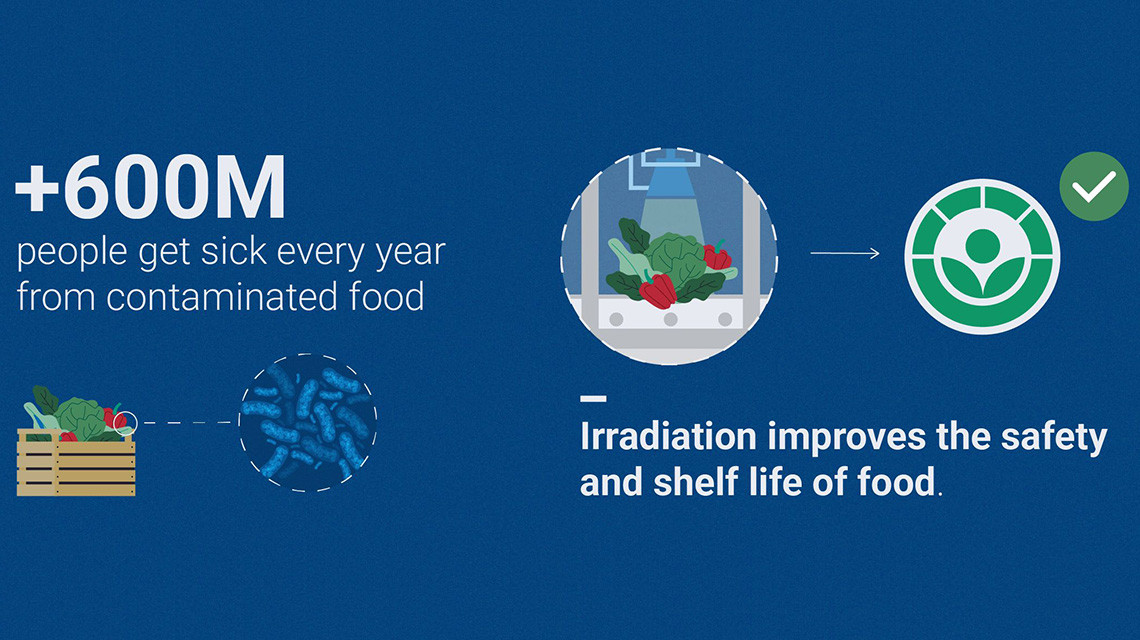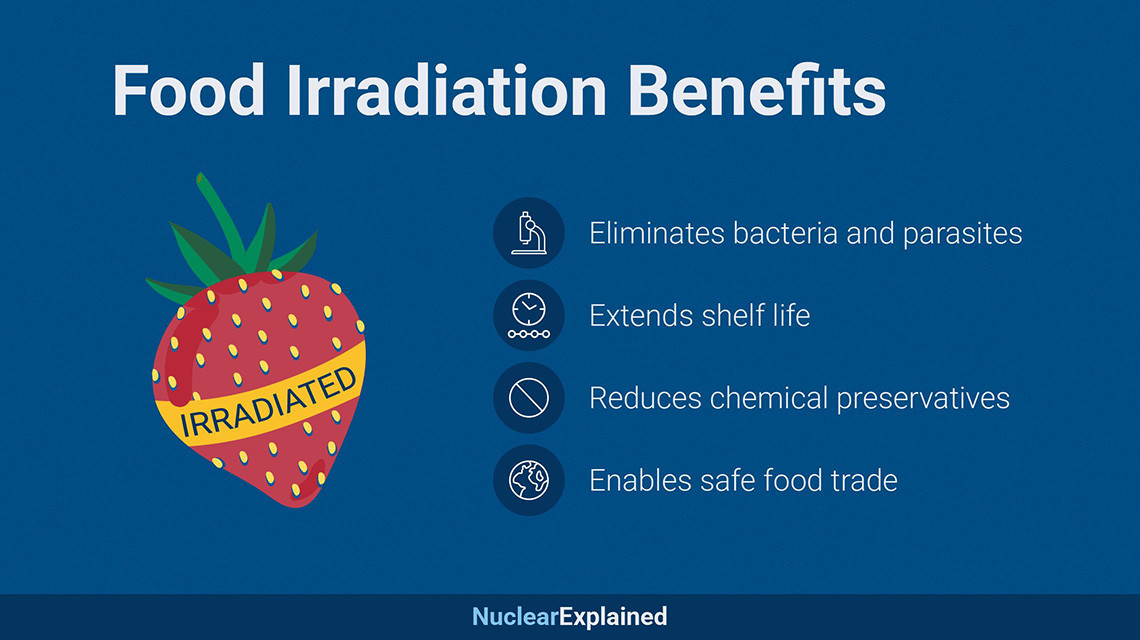Food irradiation is a gentle, non-invasive technique that uses radiation to keep food fresh and safe to eat. It eliminates microbes and controls insects and other pests while preserving the nutritional content, flavour and overall quality of food. It can also be used to stop the spread of insect pests. This technique uses radiation to transfer energy into food without changing its temperature or leaving residues. It is typically used to preserve the quality of high-value food items like spices, fish and meat, and now it is also applied to exotic fruits and vegetables.
Ensuring that food is available in adequate amounts but also nutritious and safe to eat is essential to food security. However, food is not just sustenance and nutrition; it is also part of our cultural heritage and identity. It is important that many techniques are available for making food safe to eat and wholesome while making sure it tastes, feels, smells, and looks good.
Food irradiation effectively extends the useful shelf life of food, reduces waste and ensures that consumers have access to fresh, top-quality products. For example, it can help fresh strawberries stored in a fridge last up to seven days longer.
Why is Food Irradiated?
Food irradiation has numerous benefits:
- Eliminates microbial contamination: Destroys bacteria, moulds and yeast that cause food poisoning and spoilage.
- Lowers food-borne disease risk: Reduces the risk of food-borne diseases caused by micro-organisms, especially in meat, poultry and fish.
- Reduces use of chemicals: Avoids the need for chemicals to kill microbes, delay ripening or prevent sprouting in foods like potatoes, yams, ginger, onions and garlic. It also provides an alternative to fumigants used to disinfest imported fruits, grains and vegetables.
- Extends shelf life: Prevents sprouting or germination such as in potatoes and onions.
- Delays ripening: Delays ripening of fruits and increases longevity.
- Maintains quality: it can supplement other methods of food preservation to enhance the safety of products. For example, it can be used in combination with drying, packaging or freezing, such as dried spices, pre-packaged meat and frozen seafood.
- Controls insect pests: Prevents insect pests from being able to reproduce, enabling trade over quarantine boundaries. It can also eliminate storage pests responsible for losses of wheat, rice, flour and more.
- Enables export: Allows countries to export to destinations with stringent quarantine controls on pest species or tight food safety rules.
Making Fruit and Vegetables Last Longer with Food Irradiation
Food irradiation, using X-rays or gamma rays, helps countries prevent fruit and vegetables from going to waste. With the support of the IAEA, a food irradiation facility in Havana, Cuba has reopened after 20 years.
How is Food Irradiated?
Irradiation uses beams of electrons or electromagnetic waves of radiation that have enough energy to break chemical bonds. This does not make the food radioactive, but it eliminates bacteria, moulds and yeasts and slows decay, which makes irradiated food entirely safe for human consumption and can lessen spoilage. Unlike other methods of preservation, it has little effect on food's taste, appearance or smell because the energy is transferred efficiently without degrading its quality.
The process is entirely automated, involving no human exposure to radiation. Packages of food travel along a conveyor belt through an irradiation chamber where they are exposed to a controlled dose of ionizing radiation, either from gamma rays, a high-energy electron beam or X-rays. The rays pass through the food in a similar manner to microwaves in a microwave oven, but unlike in a microwave oven, the food is not "cooked" by irradiation because it is not heated. The highest dosage used is equivalent to the same amount of energy needed to boil two tablespoons of water (10 kilojoules) for each kilogram of food irradiated.
Irradiation can even be used to treat food that is already packaged or frozen, carried out in a climate-controlled environment to maintain the cold-chain and keep food fresh.
The same technology is also widely used on a commercial scale across the world to sterilize medical devices, although for their complete sterilization, much higher dosages are necessary.
Why is Irradiated Food Safe to Eat?
Irradiation does not make food radioactive, nor does it change the food's texture, taste or appearance or compromise its nutritional quality. Extensive research and testing have been conducted on food irradiation, and as a result, the technique is now widely recognised as a completely safe and effective method for reducing harmful bacteria in food products.

The Radura logo is used to identify food that has been treated with radiation in line with international standards. (Graphic: A. Barber Huescar/IAEA)
How Big is the Food Irradiation Industry?
Authorities in at least 69 different countries have approved the irradiation of over 60 kinds of foods, including spices, chicken, beef, seafood, fruit, vegetables and other food products.
Food irradiation facilities must obtain regulatory approval (a licence) allowing the treatment of food from the relevant authority, which determines the specific types of food to be irradiated. About a million tons of food products are irradiated globally on an annual basis.
Using Nuclear Science in Food Irradiation
Food Irradiation involves shining electromagnetic radiation like X rays and gamma rays or electron beams onto food to maintain food quality, kill harmful bacteria and control insects. Not only does it reduce the risk of food poisoning, it can also extend the shelf life of food products.
How Does Food Irradiation Contribute to Food Safety and Security?
Enabling trade in fresh produce while stopping the spread of invasive pests to other countries during export ensures the integrity of food supply and improves availability. Food irradiation treatments are increasingly being used on fresh fruits and vegetables to prevent the spread of invasive insects because other methods have significant drawbacks. For example, fumigation chemicals can damage the ozone layer and leave residues in the food, while heat treatments degrade food quality and cold treatments take a long time, which can be detrimental for produce with a short shelf-life.
Food Irradiation and the Changing Climate
Throughout history, insect pests have posed challenges by spreading diseases, damaging crops and affecting environments, causing damage of more than 70 billion dollars a year. With climate change, insects are moving into new areas and authorities must implement strict quarantine measures - even within countries.
How Can Food Irradiation Help Grow Economies?
Today, foods are produced, processed, delivered and consumed in ways that could not have been anticipated only 20 years ago. Not only do we need to grow more food for an increasing world population, but we also need to do better with what is produced. A lot of food never reaches people. Food loss and waste are a pressing challenge. The FAO reports that globally, 14 percent of food is spoiled before it even reaches shops and market stalls (valued at an estimated USD 400 billion). Another 17 percent is wasted at retail outlets and by consumers. This represents an enormous waste of resources, which not only impacts food security and nutrition, but also significantly contributes to greenhouse gas emissions, environmental pollution and loss of natural ecosystems and biodiversity.
Food safety is a public health priority, but it is also crucial for fostering economic development and improving livelihoods by promoting access to domestic, regional and international markets. The economies of many countries would be significantly improved if they could prevent food spoilage, reduce the incidence of food poisoning, supply more food domestically or export more food and agricultural products. Unfortunately, many products cannot be traded because of the risk of spreading harmful pests, contamination with microorganisms or because they spoil before they reach their destination.
As a result, when developing countries try to sell their food products abroad, they often face major challenges in meeting the stringent quality and quarantine standards imposed by the major importing countries.
By irradiating food, countries can ensure that it meets international standards and export it to all markets, including those with the tightest importation rules.
Irradiation is a safe and effective technology for resolving technical problems in the trade of many food and agricultural products, either as a stand-alone technology or in combination with others.
What is the Role of the IAEA?
- The IAEA supports the safe and appropriate use of nuclear and related technologies in food and agriculture, contributing to global food security and sustainable agricultural development worldwide.
- The Joint FAO/IAEA Centre of Nuclear Techniques in Food and Agriculture develops nuclear technologies to improve the safety and quality of food products.
- The Joint FAO/IAEA Centre supports countries in improving their laboratory and regulatory capacity to trade safe and high-quality food products.
- The IAEA and the FAO collaborate with national authorities, research institutions and industry stakeholders and conduct research to improve the efficiency and efficacy of irradiation technologies.
- The two organizations work closely with the and the Codex Alimentarius Commission to harmonize worldwide irradiation standards to protect plant health and to ensure global food safety and quality.











